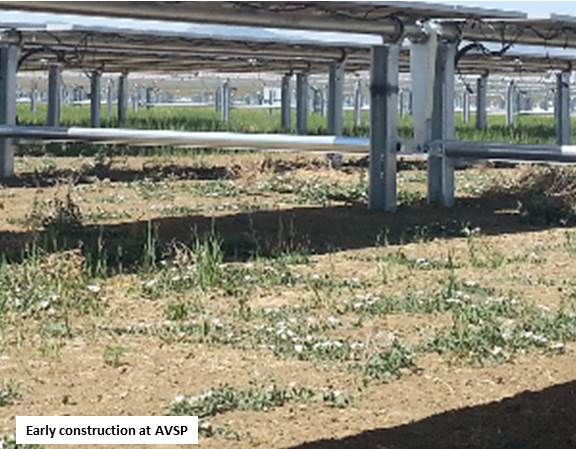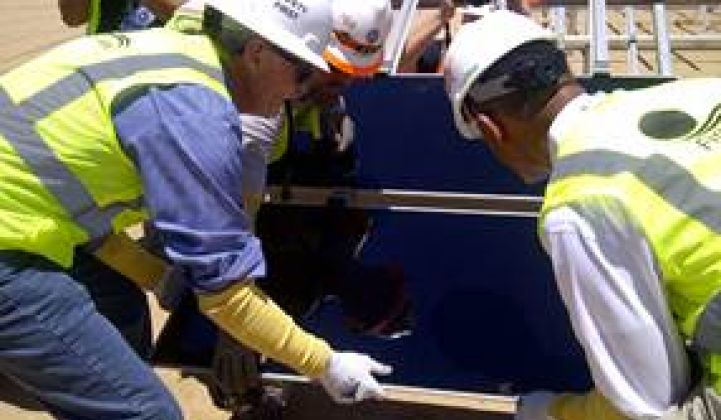Construction has resumed on First Solar's 230-megawatt solar power plant in Antelope Valley.
Concerns about management of dust from Antelope Valley Solar Ranch One (AVSR1) have been resolved, according to First Solar (NASDAQ:FSLR) Global Communications Director Steve Krum.
A brush fire in the earliest phase of operation and later concerns about electrical safety of First Solar’s PV panels have led to slowdowns in development.
In response to notices in April from the Antelope Valley Air Quality Management District (AVAQMD) and the County of Los Angeles, some construction had been stopped on the last phase of the facility although it continued to generate electricity from the 150-megawatt portion already completed.
Complaints of fugitive dust from the AVSR1 site became a concern with reports of a spike in cases of Valley fever (coccidioidomycosis). Valley fever is caused by a fungus that lives in desert region soil and can cause pneumonia when breathed with wind-borne dust. When recognized, antifungals usually address the condition.
First Solar, the County and AVAQMD reviewed the content of the dust mitigation plan that had been filed with the County before starting construction, Krum said, and arrived at a series of changes in its practices to resolve existing Notices of Violation (NOVs) and Notices of Concern (NOCs).
Several methods will be used to mitigate dust, Krum said, including:
- Maintaining a gravel boundary on the roads inside the project between the panels
- Dispersing an enhanced palliative (a calcium chloride compound) to control dust on all roads inside the project
- Using silt screens to help contain the generation of airborne sand particles during high wind periods
The notices are “resolved and closed,” Krum said. Construction continues without impediment and the project is “on schedule for completion by the end of the year.”
“They have done some good mitigations,” County Regional Planning Principal Planner Kim Szalay said. “Putting the new compound on the internal roads makes the surface harder and holds the dust down better. The silt screens around the perimeter are keeping dust inside.”
In the wake of the incidents at AVSR1, the Los Angeles County Board of Supervisors unanimously approved an amendment proposed by Antelope Valley region Supervisor Michael Antonovich to County Codes governing solar power plant construction.
“There have been recent reports of Valley fever contracted by construction workers connected to two utility-scale photovoltaic facilities” in nearby San Luis Obispo County, Antonovich noted in his motion to amend the County’s codes.
“These projects can create excessive dust during construction,” the motion added, and, because many are near residences, they could expose both workers and residents to airborne fungi that are carried in the wind along with the dust “if appropriate measures are not taken to minimize ground disturbance.”
“Mass grading” and “disking and scraping,” Antonovich’s motion read, “have the potential to generate excessive dust.”
First Solar used similar methods of ground preparation at AVSR1, methods recently described by two other Antelope Valley solar power plant developers as “unacceptable” and “inappropriate” in off-the-record conversations with GTM.
The Antonovich motion declared such methods “unnecessary since solar photovoltaic panels typically sit on concrete or steel piers that can be individually dug and poured to the correct height and level irrespective of the terrain.”
The Antonovich motion called for requiring all solar energy facilities in the County to use “an alternative to mass grading, disking and scraping” and for work on access roads, walkways, required basins and berms to be “permanently stabilized” with a County-approved substance to “prevent fugitive dust.”
At the recent town council meeting of the community most immediately adjacent to AVSR1, which is also the community that is closest to the under-construction MidAmerican Solar (MDPWK) 579-megawatt PV solar power plant, residents planned efforts to obtain up-to-date statistics on Valley fever from the Centers for Disease Control.

During an April Ceremony celebrating early construction of the Antelope Valley Solar Projects, SunPower’s (SPWR) President Howard Wenger pointed out how his company’s “light on the land” approach minimizes dust-causing construction practices. SunPower also hires local farmers, Wenger said, to assure that best local practices are exercised.
Antonovich Deputy Norm Hickling said the County and AVAQMD continue to monitor First Solar’s activities at AVSR1.
“They have clearances. but that doesn’t mean they don’t have to continue undergoing inspections by the County,” Szalay said. “The final blocks may present new challenges because they will be installing trackers and it will probably take longer.”



